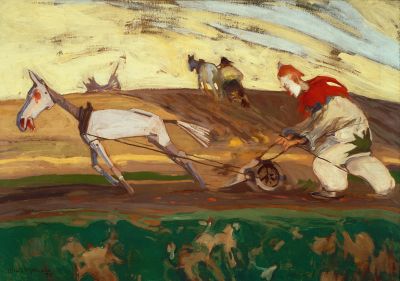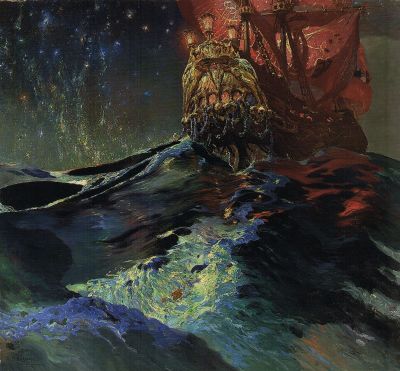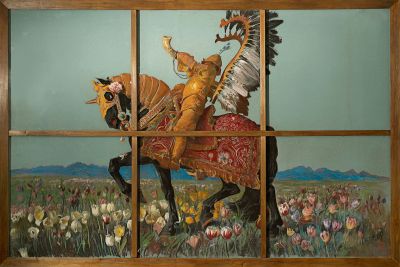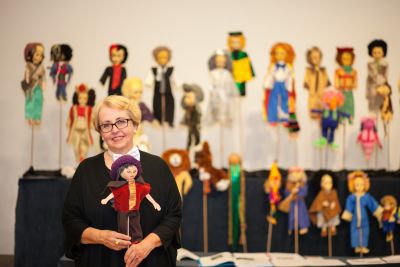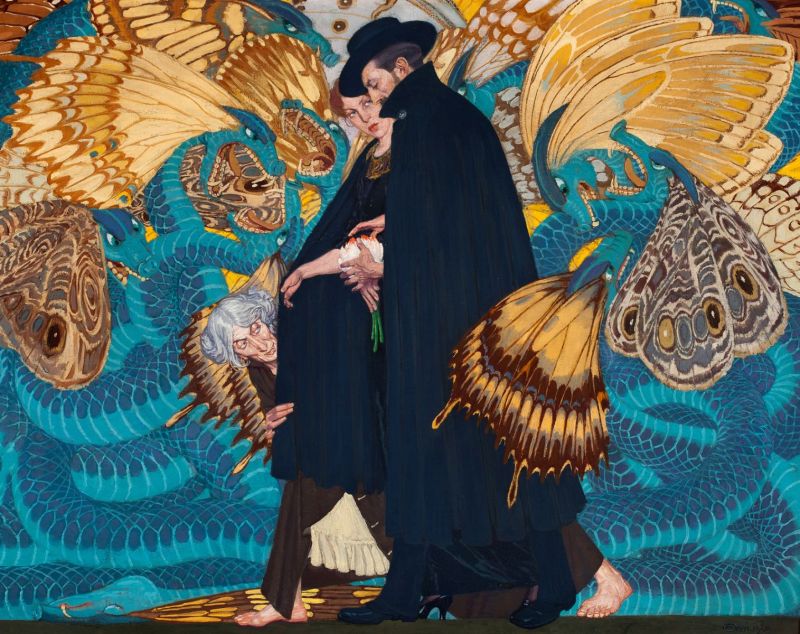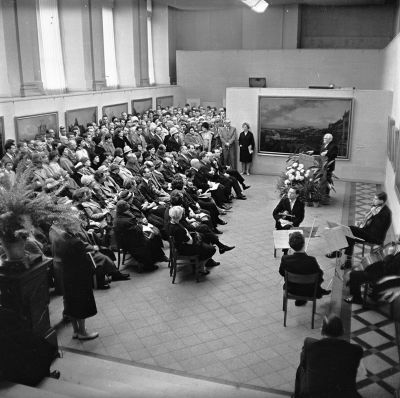Fig. 1: The Hanging of the Sigismund Bell, 1874 Fig. 1: The Hanging of the Sigismund Bell, 1874 - Jan Matejko: The Hanging of the Sigismund Bell at the Cathedral Tower in Kraków in 1521, 1874 Oil on board, 94 x 189 cm, National Museum of Warsaw/Muzeum Narodowe w Warszawie © MN Cyfrowe, https://cyfrowe.mnw.art.pl/
Fig. 2: Stańczyk, 1862 - Jan Matejko: Stańczyk, 1862. Oil on canvas, 88 x 120 cm, National Museum of Warsaw/Muzeum Narodowe w Warszawie © MN Cyfrowe, https://cyfrowe.mnw.art.pl/
Fig. 3: Without Land, 1888 Fig. 3: Without Land, 1888 - Wojciech Gerson: Without Land. Pomeranians, Driven by the Germans to the Baltic Islands, 1888. Oil on canvas, 114.8 x 207 cm, National Museum of Szczecin/Muzeum Narodowe w Szczecinie © Public Domain
Fig. 4: Room 2. The Art Centres Kraków and Warsaw (“Silent Rebels” exhibition) Fig. 4: Room 2. The Art Centres Kraków and Warsaw (“Silent Rebels” exhibition) - J. Malczewski, “Painter’s Inspiration”, 1897; “Vicious Circle”, 1895/97; “Painter’s Dream”, ca. 1888; J. Matejko: “Blind Veit Stoss with his Granddaughter”, 1865; W. Gerson: “Veit Stoss on the Road to... © Kunsthalle München, photo: Michael Naumann
Fig. 1: The Hanging of the Sigismund Bell, 1874
Jan Matejko: The Hanging of the Sigismund Bell at the Cathedral Tower in Kraków in 1521, 1874 Oil on board, 94 x 189 cm, National Museum of Warsaw/Muzeum Narodowe w Warszawie
Jan Matejko: Stańczyk, 1862. Oil on canvas, 88 x 120 cm, National Museum of Warsaw/Muzeum Narodowe w Warszawie
Fig. 3: Without Land, 1888
Wojciech Gerson: Without Land. Pomeranians, Driven by the Germans to the Baltic Islands, 1888. Oil on canvas, 114.8 x 207 cm, National Museum of Szczecin/Muzeum Narodowe w Szczecinie
Fig. 4: Room 2. The Art Centres Kraków and Warsaw (“Silent Rebels” exhibition)
J. Malczewski, “Painter’s Inspiration”, 1897; “Vicious Circle”, 1895/97; “Painter’s Dream”, ca. 1888; J. Matejko: “Blind Veit Stoss with his Granddaughter”, 1865; W. Gerson: “Veit Stoss on the Road to...
Fig. 5: Vicious Circle, 1895–1897 Fig. 5: Vicious Circle, 1895–1897 - Jacek Malczewski: Vicious Circle, 1895–1897. Oil on canvas, 174 x 240 cm, Raczyński Foundation, National Museum of Poznań/Fundacja im. Raczyńskich przy Muzeum Narodowym w Poznaniu © Public Domain
Fig. 6: Room 3. In Dialogue with European Art. (“Silent Rebels” exhibition) Fig. 6: Room 3. In Dialogue with European Art. (“Silent Rebels” exhibition) - A. Gierymski, “The Ludwig Bridge in Munich”, 1896/97; W. Czachórski, “Cemetery in Venice”, 1876; W. Pruszkowski, “All Souls”, 1888; J. Pankiewicz, “Cart Loaded with Hay”, 1890; L. Wyczółkowski, “Fishe... © Kunsthalle München, photo: Michael Naumann
Fig. 7: Indian Summer, 1875 Fig. 7: Indian Summer, 1875 - Józef Chełmoński: Indian Summer, 1875. Oil on canvas, 119.5 x 156 cm, inv. no. MP 423 MNW, National Museum of Warsaw/Muzeum Narodowe w Warszawie © MN Cyfrowe, https://cyfrowe.mnw.art.pl/
Fig. 8: The Ludwig Bridge in Munich, 1896/97 Fig. 8: The Ludwig Bridge in Munich, 1896/97 - Aleksander Gierymski: The Ludwig Bridge in Munich, 1896/97. Oil on canvas, 81 x 60 cm, inv. no. MP 4758 MNW, National Museum of Warsaw/Muzeum Narodowe w Warszawie © MN Cyfrowe, https://cyfrowe.mnw.art.pl/
Fig. 5: Vicious Circle, 1895–1897
Jacek Malczewski: Vicious Circle, 1895–1897. Oil on canvas, 174 x 240 cm, Raczyński Foundation, National Museum of Poznań/Fundacja im. Raczyńskich przy Muzeum Narodowym w Poznaniu
Fig. 6: Room 3. In Dialogue with European Art. (“Silent Rebels” exhibition)
A. Gierymski, “The Ludwig Bridge in Munich”, 1896/97; W. Czachórski, “Cemetery in Venice”, 1876; W. Pruszkowski, “All Souls”, 1888; J. Pankiewicz, “Cart Loaded with Hay”, 1890; L. Wyczółkowski, “Fishe...
Fig. 7: Indian Summer, 1875
Józef Chełmoński: Indian Summer, 1875. Oil on canvas, 119.5 x 156 cm, inv. no. MP 423 MNW, National Museum of Warsaw/Muzeum Narodowe w Warszawie
Fig. 8: The Ludwig Bridge in Munich, 1896/97
Aleksander Gierymski: The Ludwig Bridge in Munich, 1896/97. Oil on canvas, 81 x 60 cm, inv. no. MP 4758 MNW, National Museum of Warsaw/Muzeum Narodowe w Warszawie
Fig. 9: Cart Loaded with Hay, 1890 Fig. 9: Cart Loaded with Hay, 1890 - Józef Pankiewicz: Cart Loaded with Hay, 1890. Oil on canvas, 50.5 x 69.2 cm, National Museum of Kraków/Muzeum Narodowe w Krakowie © Public Domain
Fig. 10: A Japanese Woman, 1908 Fig. 10: A Japanese Woman, 1908 - Józef Pankiewicz: A Japanese Woman, 1908. Oil on canvas, 200 x 94 cm, National Museum of Kraków/Muzeum Narodowe w Krakowie © Public Domain
Fig. 11: Room 4. Polish Landscapes (“Silent Rebels” exhibition) Fig. 11: Room 4. Polish Landscapes (“Silent Rebels” exhibition) - F. Ruszczyc: “Cloud”, 1902; “Winter Fairy Tale”, 1904; “Old Apple Trees”, 1900; K. Krzyżanowski: “Verkiai near Vilnius”, 1907; five landscape sketches; K. Stabrowski: “A Breath of Autumn”, ca. 1910; J... © Kunsthalle München, photo: Michael Naumann
Fig. 12: Poplars Beside the River, 1900 Fig. 12: Poplars Beside the River, 1900 - Jan Stanisławski: Poplars Beside the River, 1900. Oil on canvas, 145.5 x 80.5 cm, inv. no. MNK II-b-550, National Museum of Kraków/Muzeum Narodowe w Krakowie © MNK Digital Collections, https://zbiory.mnk.pl/
Fig. 9: Cart Loaded with Hay, 1890
Józef Pankiewicz: Cart Loaded with Hay, 1890. Oil on canvas, 50.5 x 69.2 cm, National Museum of Kraków/Muzeum Narodowe w Krakowie
Fig. 10: A Japanese Woman, 1908
Józef Pankiewicz: A Japanese Woman, 1908. Oil on canvas, 200 x 94 cm, National Museum of Kraków/Muzeum Narodowe w Krakowie
Fig. 11: Room 4. Polish Landscapes (“Silent Rebels” exhibition)
F. Ruszczyc: “Cloud”, 1902; “Winter Fairy Tale”, 1904; “Old Apple Trees”, 1900; K. Krzyżanowski: “Verkiai near Vilnius”, 1907; five landscape sketches; K. Stabrowski: “A Breath of Autumn”, ca. 1910; J...
Fig. 12: Poplars Beside the River, 1900
Jan Stanisławski: Poplars Beside the River, 1900. Oil on canvas, 145.5 x 80.5 cm, inv. no. MNK II-b-550, National Museum of Kraków/Muzeum Narodowe w Krakowie
Fig. 13: Cloud, 1902 - Ferdynand Ruszczyc: Cloud, 1902. Oil on canvas, 103.5 x 78 cm, National Museum of Poznań/Muzeum Narodowe w Poznaniu © Muzeum Narodowe w Poznaniu
Fig. 14: Room 5. Spring Awakening (“Silent Rebels” exhibition) Fig. 14: Room 5. Spring Awakening (“Silent Rebels” exhibition) - J. Malczewski: “Spring”, 1898; W. Hofman: “Spring”, 1918; “Nativity Scene”, 1918; K. Sichulski: “Spring” triptych, 1909 © Kunsthalle München, photo: Michael Naumann
Fig. 15: Spring, 1898 - Wojciech Weiss: Spring, 1898. Oil on canvas, 96.5 x 65.5 cm, inv. no. MP 3879 MNW, National Museum of Warsaw/Muzeum Narodowe w Warszawie © MN Cyfrowe, https://cyfrowe.mnw.art.pl/
Fig. 16: My Models, 1897 - Jacek Malczewski: My Models, 1897. Oil on canvas, 63 x 36 cm, inv. no. MNK II-b-159, National Museum of Kraków/Muzeum Narodowe w Krakowie © MNK Digital Collections, https://zbiory.mnk.pl/
Ferdynand Ruszczyc: Cloud, 1902. Oil on canvas, 103.5 x 78 cm, National Museum of Poznań/Muzeum Narodowe w Poznaniu
Fig. 14: Room 5. Spring Awakening (“Silent Rebels” exhibition)
J. Malczewski: “Spring”, 1898; W. Hofman: “Spring”, 1918; “Nativity Scene”, 1918; K. Sichulski: “Spring” triptych, 1909
Wojciech Weiss: Spring, 1898. Oil on canvas, 96.5 x 65.5 cm, inv. no. MP 3879 MNW, National Museum of Warsaw/Muzeum Narodowe w Warszawie
Jacek Malczewski: My Models, 1897. Oil on canvas, 63 x 36 cm, inv. no. MNK II-b-159, National Museum of Kraków/Muzeum Narodowe w Krakowie
Fig. 17: Death, 1902 - Jacek Malczewski: Death, 1902. Oil on canvas, 98 x 75 cm, inv. no. MP 373 MNW, National Museum of Warsaw/Muzeum Narodowe w Warszawie © MN Cyfrowe, https://cyfrowe.mnw.art.pl/
Fig. 18: In the Dust Storm, 1893–1895 Fig. 18: In the Dust Storm, 1893–1895 - Jacek Malczewski: In the Dust Storm, 1893–1895. Oil on canvas, 78 x 150 cm, Raczyński Foundation, National Museum of Poznań/Fundacja im. Raczyńskich przy Muzeum Narodowym w Poznaniu © Public Domain
Fig. 19: Derwid, 1902 - Jacek Malczewski: Derwid, 1902. Oil on board, 53 x 45 cm, inv. no. MNK II-b-900, National Museum of Kraków/Muzeum Narodowe w Krakowie © MNK Digital Collections, https://zbiory.mnk.pl/
Fig. 20: Peasant Coffin, 1894 Fig. 20: Peasant Coffin, 1894 - Aleksander Gierymski: Peasant Coffin, 1894. Oil on canvas, 141 x 195 cm, inv. no. MP 964 MNW, National Museum of Warsaw/Muzeum Narodowe w Warszawie © MN Cyfrowe, https://cyfrowe.mnw.art.pl/
Jacek Malczewski: Death, 1902. Oil on canvas, 98 x 75 cm, inv. no. MP 373 MNW, National Museum of Warsaw/Muzeum Narodowe w Warszawie
Fig. 18: In the Dust Storm, 1893–1895
Jacek Malczewski: In the Dust Storm, 1893–1895. Oil on canvas, 78 x 150 cm, Raczyński Foundation, National Museum of Poznań/Fundacja im. Raczyńskich przy Muzeum Narodowym w Poznaniu
Jacek Malczewski: Derwid, 1902. Oil on board, 53 x 45 cm, inv. no. MNK II-b-900, National Museum of Kraków/Muzeum Narodowe w Krakowie
Fig. 20: Peasant Coffin, 1894
Aleksander Gierymski: Peasant Coffin, 1894. Oil on canvas, 141 x 195 cm, inv. no. MP 964 MNW, National Museum of Warsaw/Muzeum Narodowe w Warszawie
Fig. 21: Musicians in Bronowice, 1891 Fig. 21: Musicians in Bronowice, 1891 - Włodzimierz Tetmajer: Musicians in Bronowice. Before the Inn, 1891. Oil on canvas, 106 x 182 cm, inv. no. MP 5500 MNW, National Museum of Warsaw/Muzeum Narodowe w Warszawie © MN Cyfrowe, https://cyfrowe.mnw.art.pl/
Fig. 22: Kołomyjka, 1895 - Teodor Axentowicz: Kołomyjka, 1895. Oil on canvas, 85 x 112.5 cm, inv. no. MP 359 MNW, National Museum of Warsaw/Muzeum Narodowe w Warszawie © MN Cyfrowe, https://cyfrowe.mnw.art.pl/
Fig. 23: Room 7. Tradition and Religion (“Silent Rebels” exhibition) Fig. 23: Room 7. Tradition and Religion (“Silent Rebels” exhibition) - W. Jarocki: “Hutsuls in the Carpathians”, 1910; “Helenka from Poronin”, 1913; W. Tetmajer: “Musicians in Bronowice”, 1891; T. Axentowicz: “Kołomyjka”, 1895 © Kunsthalle München, photo: Michael Naumann
Fig. 24: Room 8. Portraits (“Silent Rebels” exhibition) Fig. 24: Room 8. Portraits (“Silent Rebels” exhibition) - E. Okuń: “Self-Portrait in Spanish Costume”, 1911; J. Fałat: “Self-Portrait”, 1896; J. Malczewski: “On One String. Self-Portrait”, 1908; J. Malczewski: “The Story of a Song. Portrait of Adam Asnyk”, 1... © Kunsthalle München, photo: Michael Naumann
Fig. 21: Musicians in Bronowice, 1891
Włodzimierz Tetmajer: Musicians in Bronowice. Before the Inn, 1891. Oil on canvas, 106 x 182 cm, inv. no. MP 5500 MNW, National Museum of Warsaw/Muzeum Narodowe w Warszawie
Teodor Axentowicz: Kołomyjka, 1895. Oil on canvas, 85 x 112.5 cm, inv. no. MP 359 MNW, National Museum of Warsaw/Muzeum Narodowe w Warszawie
Fig. 23: Room 7. Tradition and Religion (“Silent Rebels” exhibition)
W. Jarocki: “Hutsuls in the Carpathians”, 1910; “Helenka from Poronin”, 1913; W. Tetmajer: “Musicians in Bronowice”, 1891; T. Axentowicz: “Kołomyjka”, 1895
Fig. 24: Room 8. Portraits (“Silent Rebels” exhibition)
E. Okuń: “Self-Portrait in Spanish Costume”, 1911; J. Fałat: “Self-Portrait”, 1896; J. Malczewski: “On One String. Self-Portrait”, 1908; J. Malczewski: “The Story of a Song. Portrait of Adam Asnyk”, 1...
Fig. 25: On One String, 1908 Fig. 25: On One String, 1908 - Jacek Malczewski: On One String. Self-Portrait, 1908. Oil on canvas, 92 x 73 cm, inv. no. MP 1276 MNW, National Museum of Warsaw/Muzeum Narodowe w Warszawie © MN Cyfrowe, https://cyfrowe.mnw.art.pl/
Fig. 26: Self-Portrait with Masks, 1900 Fig. 26: Self-Portrait with Masks, 1900 - Wojciech Weiss: Self-Portrait with Masks, 1900. Oil on canvas, 90 x 72 cm, inv. no. MNK II-b-877, National Museum of Kraków/Muzeum Narodowe w Krakowie © MNK Digital Collections, https://zbiory.mnk.pl/
Fig. 27: Portrait of the Artist’s Wife with Pegasus, 1913 Fig. 27: Portrait of the Artist’s Wife with Pegasus, 1913 - Józef Mehoffer: Portrait of the Artist’s Wife with Pegasus, 1913. Oil on canvas, 95 x 78 cm, National Museum of Kraków/Muzeum Narodowe w Krakowie © Public Domain
Fig. 28: Portrait of a Woman, 1891 Fig. 28: Portrait of a Woman, 1891 - Olga Boznańska: Portrait of a Woman, 1891. Oil on canvas, 122 x 80 cm, inv. no. MP531 MNW, National Museum of Warsaw/Muzeum Narodowe w Warszawie © MN Cyfrowe, https://cyfrowe.mnw.art.pl/
Fig. 25: On One String, 1908
Jacek Malczewski: On One String. Self-Portrait, 1908. Oil on canvas, 92 x 73 cm, inv. no. MP 1276 MNW, National Museum of Warsaw/Muzeum Narodowe w Warszawie
Fig. 26: Self-Portrait with Masks, 1900
Wojciech Weiss: Self-Portrait with Masks, 1900. Oil on canvas, 90 x 72 cm, inv. no. MNK II-b-877, National Museum of Kraków/Muzeum Narodowe w Krakowie
Fig. 27: Portrait of the Artist’s Wife with Pegasus, 1913
Józef Mehoffer: Portrait of the Artist’s Wife with Pegasus, 1913. Oil on canvas, 95 x 78 cm, National Museum of Kraków/Muzeum Narodowe w Krakowie
Fig. 28: Portrait of a Woman, 1891
Olga Boznańska: Portrait of a Woman, 1891. Oil on canvas, 122 x 80 cm, inv. no. MP531 MNW, National Museum of Warsaw/Muzeum Narodowe w Warszawie
Fig. 29: Melancholic, 1898 Fig. 29: Melancholic, 1898 - Wojciech Weiss: Melancholic (Requiem), 1898. Oil on canvas, 128 x 65.5 cm, inv. no. MNK II-b-2158, National Museum of Kraków/Muzeum Narodowe w Krakowie © MNK Digital Collections, https://zbiory.mnk.pl/
Fig. 30: Obsession, 1899/1900 Fig. 30: Obsession, 1899/1900 - Wojciech Weiss: Obsession, 1899/1900. Oil on canvas, 101 x 186 cm, Literature Museum of Warsaw/Muzeum Literatury im. Adama Mickiewicza w Warszawie, on permanent loan to the National Museum of Warsaw/M... © Public Domain
Fig. 31: Frenzy, 1893 - Władysław Podkowiński: Frenzy, sketch, 1893. Oil on canvas, 56 x 46 cm, inv. no. MP 338 MNW, National Museum of Warsaw/Muzeum Narodowe w Warszawie © MN Cyfrowe, https://cyfrowe.mnw.art.pl/
Fig. 32: Funeral March, 1894 Fig. 32: Funeral March, 1894 - Władysław Podkowiński: Funeral March, 1894. Oil on canvas, 83.5 x 119.5 cm, inv. no. MNK II-b-154, National Museum of Kraków/Muzeum Narodowe w Krakowie © MNK Digital Collections, https://zbiory.mnk.pl/
Fig. 29: Melancholic, 1898
Wojciech Weiss: Melancholic (Requiem), 1898. Oil on canvas, 128 x 65.5 cm, inv. no. MNK II-b-2158, National Museum of Kraków/Muzeum Narodowe w Krakowie
Fig. 30: Obsession, 1899/1900
Wojciech Weiss: Obsession, 1899/1900. Oil on canvas, 101 x 186 cm, Literature Museum of Warsaw/Muzeum Literatury im. Adama Mickiewicza w Warszawie, on permanent loan to the National Museum of Warsaw/M...
Władysław Podkowiński: Frenzy, sketch, 1893. Oil on canvas, 56 x 46 cm, inv. no. MP 338 MNW, National Museum of Warsaw/Muzeum Narodowe w Warszawie
Fig. 32: Funeral March, 1894
Władysław Podkowiński: Funeral March, 1894. Oil on canvas, 83.5 x 119.5 cm, inv. no. MNK II-b-154, National Museum of Kraków/Muzeum Narodowe w Krakowie
Fig. 33: The Indecent Woman, 1904 Fig. 33: The Indecent Woman, 1904 - Witold Wojtkiewicz: The Indecent Woman (Fallen Woman), 1904. From the “Tragicomic Sketches” cycle, ink, gouache, coloured pencil on paper, 47.5 x 38.7 cm, inv. no. MNK III-r.a-11688, National Museum o... © MNK Digital Collections, https://zbiory.mnk.pl/
Fig. 34: Circus I, 1907 - Witold Wojtkiewicz: Circus I, 1907. Oil on canvas, 59.5 x 71.5 cm, Silesian Museum, Katowice/Muzeum Śląskie w Katowicach © Public Domain
Fig. 35: Ploughing, 1905 - Witold Wojtkiewicz: Ploughing, 1905. Oil on canvas, 57.7 x 96 cm, inv. no. MP 5157 MNW, National Museum of Warsaw/Muzeum Narodowe w Warszawie © MN Cyfrowe, https://cyfrowe.mnw.art.pl/
Fig. 36: The Painter’s Inspiration, 1897 Fig. 36: The Painter’s Inspiration, 1897 - Jacek Malczewski: The Painter’s Inspiration, 1897. Oil on canvas, 79 x 64 cm, MNK II-b-2543, National Museum of Kraków/Muzeum Narodowe w Krakowie © MNK Digital Collections, https://zbiory.mnk.pl/
Fig. 33: The Indecent Woman, 1904
Witold Wojtkiewicz: The Indecent Woman (Fallen Woman), 1904. From the “Tragicomic Sketches” cycle, ink, gouache, coloured pencil on paper, 47.5 x 38.7 cm, inv. no. MNK III-r.a-11688, National Museum o...
Witold Wojtkiewicz: Circus I, 1907. Oil on canvas, 59.5 x 71.5 cm, Silesian Museum, Katowice/Muzeum Śląskie w Katowicach
Witold Wojtkiewicz: Ploughing, 1905. Oil on canvas, 57.7 x 96 cm, inv. no. MP 5157 MNW, National Museum of Warsaw/Muzeum Narodowe w Warszawie
Fig. 36: The Painter’s Inspiration, 1897
Jacek Malczewski: The Painter’s Inspiration, 1897. Oil on canvas, 79 x 64 cm, MNK II-b-2543, National Museum of Kraków/Muzeum Narodowe w Krakowie
Fig. 37: Room 11. Polonia (“Silent Rebels” exhibition) Fig. 37: Room 11. Polonia (“Silent Rebels” exhibition) - J. Malczewski: “Polish Hamlet” (1903); “Pythia”, 1917; “Young Poland”, 1917; L. Wyczółkowski: “Knight Surrounded by Flowers”, 1904; J. Malczewski: “Slavery – War – Liberty” triptych, 1917 © Kunsthalle München, photo: Michael Naumann
Fig. 38: Nec mergitur, 1904/05 Fig. 38: Nec mergitur, 1904/05 - Ferdynand Ruszczyc: Nec mergitur, 1904/05. Oil on canvas, 219 x 203 cm, Lithuanian National Museum of Art/Lietuvos nacionalinis dailės muziejus, Vilnius © Public Domain
Fig. 39: Knight Surrounded by Flowers, 1904 Fig. 39: Knight Surrounded by Flowers, 1904 - Leon Wyczółkowski: Knight Surrounded by Flowers, 1904. Pastel on paper, 176 x 300 cm, Société Historique et Littéraire Polonaise/Bibliothèque Polonaise de Paris © Public Domain
Fig. 40: Pythia, 1917 - Jacek Malczewski: Pythia, 1917. Oil on canvas, 210 x 110 cm, National Museum of Kraków/Muzeum Narodowe w Krakowie © Public Domain
Fig. 37: Room 11. Polonia (“Silent Rebels” exhibition)
J. Malczewski: “Polish Hamlet” (1903); “Pythia”, 1917; “Young Poland”, 1917; L. Wyczółkowski: “Knight Surrounded by Flowers”, 1904; J. Malczewski: “Slavery – War – Liberty” triptych, 1917
Fig. 38: Nec mergitur, 1904/05
Ferdynand Ruszczyc: Nec mergitur, 1904/05. Oil on canvas, 219 x 203 cm, Lithuanian National Museum of Art/Lietuvos nacionalinis dailės muziejus, Vilnius
Fig. 39: Knight Surrounded by Flowers, 1904
Leon Wyczółkowski: Knight Surrounded by Flowers, 1904. Pastel on paper, 176 x 300 cm, Société Historique et Littéraire Polonaise/Bibliothèque Polonaise de Paris
Jacek Malczewski: Pythia, 1917. Oil on canvas, 210 x 110 cm, National Museum of Kraków/Muzeum Narodowe w Krakowie
Edward Okuń: The War and Us, 1917–1923 Edward Okuń: The War and Us, 1917–1923 - Oil on canvas, 88 x 111 cm, inv. no. MP 387 MNW, National Museum of Warsaw/Muzeum Narodowe w Warszawie © MN Cyfrowe, https://cyfrowe.mnw.art.pl/
Edward Okuń: The War and Us, 1917–1923
Oil on canvas, 88 x 111 cm, inv. no. MP 387 MNW, National Museum of Warsaw/Muzeum Narodowe w Warszawie


































